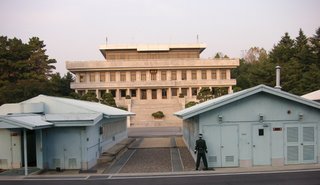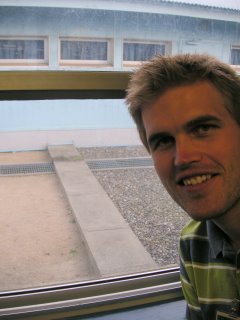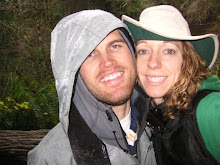Monday, October 23, 2006
DMZ Tour...continued
Here's where the tour got exciting. Sam and I had no idea that we would actually be going INTO the DMZ when we signed up for this tour. We didn't know that civilian groups were even allowed in. But, that's where we headed next. We arrived at "Camp Bonifas", the military base on the outer, southern border of the DMZ. Our passports were checked, and then we were taken to a meeting hall, where we were "briefed" on the situation at the DMZ. We were given release forms to sign, and badges that we had to wear for the duration of the trip. Our military-guide was amazing. He was incredibly knowledgable, and the information he gave us was very eye-opening.
After the briefing, we headed out to the military buses, and were on our way. We knew we were actually entering the DMZ when we passed through a series of two large fences with barbed-wire twisted along the top. These fences run along the entire border of the DMZ. All along the fences, painted-white rocks were pushed between the links, and lined along the ground. We were told that these rocks are monitored frequently, and if anyone tries to mess with the fence, the rocks will be moved and the guards will know exactly where the line was breeched...a little primative, but sounds like it would be effective.
We weren't allowed to take pictures between our departure from Camp Bonifas and our arrival at the JSA. On our way, we saw the barracks of a special tactics response team who are able to be fully decked out in their equipment, in their vehichles, and anywhere in the JSA within 60 to 90 seconds...very fast! The JSA is the "Joint Security Area". It is in the dead-centre of the DMZ, and it is an area where the two sides meet to discuss the cease-fire agreement, relations and border issues. The ROK (South) soldiers have to remain on the Southern side, and the KPA (North) soldiers have to stay on the Northern side. In fact, there is a cement slab that runs the entire border length in the JSA. We were taken into the building where the armistice (cease-fire agreement) was signed at the end of the Korean War. Two Korean soldiers were standing guard. One of them was at the head of the table, and the other was by a door at the far-end of the building. We were told to stand around the table, and then our guide pointed to the side we were standing on, and told us that we were officially standing in North Korea. In the very middle of the table were three microphones (they were placed along the border line of the two countries), which recorded every word spoken in the building. Both North and South Korea had access to the audio feeds. We were told not to obstruct the ROK soldier's guard in any way. We were further instructed not to pass behind the guard who was by the far-side door. The door led to North Korea, and if we made a move to pass him, he would assume we were trying to enter the North, and would take us down.
After our time in the building, we headed back outside to a platform facing the North side of the border. We then had 7 ROK soldiers guarding us. While we were standing there, a KPA soldier came out of the building across from us, and stood post at the door. Our soldier-guide let us know that there was also another KPA soldier at the window watching us with binoculars, and then pointed at a guard tower beside their building, where another soldier was also watching us. Wenwere told not to try to speak with the North Korean soldiers, not to make any gestures, and not to try to non-verbally communicate with them. This was probably the most intense part of our tour. We could actually "feel" the tension in the air, making us very aware that these two countries are technically still at war. Sam said that at that moment he felt like he had a gun aimed at his chest (to give you an idea of what it was like to stand there).
Next we headed to a place in the JSA where we were surrounded by North Korea on 3 sides. We had an excellent view of "Propaganda Village". Both the Southern and Northern sides are allowed to have one village in the DMZ. On the south side, these villagers are only allowed to live in the village if they are born there, or have ancestors who lived there before the war. Women are allowed to marry into the village, but men are not. This is because members of the village are given complete tax exemption by the government, and the men in the village are also exempt from the 2 years of military service that is mandatory for other South Korean men. The village in the southern side is called "Freedom Village", and the residents actually make a good living from the rice paddies that surround it. The soldiers have tagged the village in the North, "Progaganda Village", because NOONE lives there, and loud-speakers used to spout out propaganda all throughout the night. People are never seen in the village, and the lights are on timers to go on and off at the same time every day. North Korea built this city to give an appearance of wealth and prosperity. They also placed an enormous flag pole in the middle of the village that holds a 600 lb. flag (supposedly they have to take it down when it rains, because the extra weight of the water causes the flag to rip!). It seems like everything they do is done with the intention of trying to appear bigger and better then the South.
Our last stop in the JSA was at the "Bridge of No Return". At the end of the Korean War, North and South Korean POW's were brought to the middle of this bridge. They were then given the option to go North or South, but were told that once they chose, they were never allowed to return to the other side. This story highlighted the fact that there are numerous families who have been divided by the border. Although South Korea has tried to open a famiy reunion centre, again, the North is unwilling to have their citizens exposed to anything outside of their borders.
This trip opened our eyes in so many ways. This was the first time that we have ever come face-to-face with communisim. We have also been reminded of the true plight of the North Korean people, and the suffering they go through because of shortages of food, and the dictatorship of such an extreme leader. Our USO tour-guide encouraged us to remember the North Koreans in our prayers, and we encourage you to do the same.
 The Bridge of No Return
The Bridge of No Return
 In this picture, I am standing in North Korea. (notice that I am standing in front of this guard...definitely did NOT want him to take me down...his is a ROK soldier).
In this picture, I am standing in North Korea. (notice that I am standing in front of this guard...definitely did NOT want him to take me down...his is a ROK soldier).
 The blue building on the left is where the Armistice was signed. Notice that the guard is standing half concealed by the building (in case gun fire was to break out). It's hard to see in this small picture, but a KPA soldier is standing at the top of the stairs of the cream-coloured building (which is on the North side)
The blue building on the left is where the Armistice was signed. Notice that the guard is standing half concealed by the building (in case gun fire was to break out). It's hard to see in this small picture, but a KPA soldier is standing at the top of the stairs of the cream-coloured building (which is on the North side)
After the briefing, we headed out to the military buses, and were on our way. We knew we were actually entering the DMZ when we passed through a series of two large fences with barbed-wire twisted along the top. These fences run along the entire border of the DMZ. All along the fences, painted-white rocks were pushed between the links, and lined along the ground. We were told that these rocks are monitored frequently, and if anyone tries to mess with the fence, the rocks will be moved and the guards will know exactly where the line was breeched...a little primative, but sounds like it would be effective.
We weren't allowed to take pictures between our departure from Camp Bonifas and our arrival at the JSA. On our way, we saw the barracks of a special tactics response team who are able to be fully decked out in their equipment, in their vehichles, and anywhere in the JSA within 60 to 90 seconds...very fast! The JSA is the "Joint Security Area". It is in the dead-centre of the DMZ, and it is an area where the two sides meet to discuss the cease-fire agreement, relations and border issues. The ROK (South) soldiers have to remain on the Southern side, and the KPA (North) soldiers have to stay on the Northern side. In fact, there is a cement slab that runs the entire border length in the JSA. We were taken into the building where the armistice (cease-fire agreement) was signed at the end of the Korean War. Two Korean soldiers were standing guard. One of them was at the head of the table, and the other was by a door at the far-end of the building. We were told to stand around the table, and then our guide pointed to the side we were standing on, and told us that we were officially standing in North Korea. In the very middle of the table were three microphones (they were placed along the border line of the two countries), which recorded every word spoken in the building. Both North and South Korea had access to the audio feeds. We were told not to obstruct the ROK soldier's guard in any way. We were further instructed not to pass behind the guard who was by the far-side door. The door led to North Korea, and if we made a move to pass him, he would assume we were trying to enter the North, and would take us down.
After our time in the building, we headed back outside to a platform facing the North side of the border. We then had 7 ROK soldiers guarding us. While we were standing there, a KPA soldier came out of the building across from us, and stood post at the door. Our soldier-guide let us know that there was also another KPA soldier at the window watching us with binoculars, and then pointed at a guard tower beside their building, where another soldier was also watching us. Wenwere told not to try to speak with the North Korean soldiers, not to make any gestures, and not to try to non-verbally communicate with them. This was probably the most intense part of our tour. We could actually "feel" the tension in the air, making us very aware that these two countries are technically still at war. Sam said that at that moment he felt like he had a gun aimed at his chest (to give you an idea of what it was like to stand there).
Next we headed to a place in the JSA where we were surrounded by North Korea on 3 sides. We had an excellent view of "Propaganda Village". Both the Southern and Northern sides are allowed to have one village in the DMZ. On the south side, these villagers are only allowed to live in the village if they are born there, or have ancestors who lived there before the war. Women are allowed to marry into the village, but men are not. This is because members of the village are given complete tax exemption by the government, and the men in the village are also exempt from the 2 years of military service that is mandatory for other South Korean men. The village in the southern side is called "Freedom Village", and the residents actually make a good living from the rice paddies that surround it. The soldiers have tagged the village in the North, "Progaganda Village", because NOONE lives there, and loud-speakers used to spout out propaganda all throughout the night. People are never seen in the village, and the lights are on timers to go on and off at the same time every day. North Korea built this city to give an appearance of wealth and prosperity. They also placed an enormous flag pole in the middle of the village that holds a 600 lb. flag (supposedly they have to take it down when it rains, because the extra weight of the water causes the flag to rip!). It seems like everything they do is done with the intention of trying to appear bigger and better then the South.
Our last stop in the JSA was at the "Bridge of No Return". At the end of the Korean War, North and South Korean POW's were brought to the middle of this bridge. They were then given the option to go North or South, but were told that once they chose, they were never allowed to return to the other side. This story highlighted the fact that there are numerous families who have been divided by the border. Although South Korea has tried to open a famiy reunion centre, again, the North is unwilling to have their citizens exposed to anything outside of their borders.
This trip opened our eyes in so many ways. This was the first time that we have ever come face-to-face with communisim. We have also been reminded of the true plight of the North Korean people, and the suffering they go through because of shortages of food, and the dictatorship of such an extreme leader. Our USO tour-guide encouraged us to remember the North Koreans in our prayers, and we encourage you to do the same.
 Here is Sam with the concrete slab that separates the JSA into North and South areas. Sam's face is on the North side of the line.
Here is Sam with the concrete slab that separates the JSA into North and South areas. Sam's face is on the North side of the line.
 The Bridge of No Return
The Bridge of No Return In this picture, I am standing in North Korea. (notice that I am standing in front of this guard...definitely did NOT want him to take me down...his is a ROK soldier).
In this picture, I am standing in North Korea. (notice that I am standing in front of this guard...definitely did NOT want him to take me down...his is a ROK soldier). The blue building on the left is where the Armistice was signed. Notice that the guard is standing half concealed by the building (in case gun fire was to break out). It's hard to see in this small picture, but a KPA soldier is standing at the top of the stairs of the cream-coloured building (which is on the North side)
The blue building on the left is where the Armistice was signed. Notice that the guard is standing half concealed by the building (in case gun fire was to break out). It's hard to see in this small picture, but a KPA soldier is standing at the top of the stairs of the cream-coloured building (which is on the North side)
Comments:
<< Home
Hi Bec and Sam,
That ROK soldier is scary!!! He looks so mean and tough yet almost like one of those wax museum guys!!!!
And you look so beautiful my Bec!!!!
Love you, Aunt Sheila xoxox
Did the ROK guy talk to you or are they like the guys who stand outside the Queen's castle in England? tee hee xoxoxox
Post a Comment
That ROK soldier is scary!!! He looks so mean and tough yet almost like one of those wax museum guys!!!!
And you look so beautiful my Bec!!!!
Love you, Aunt Sheila xoxox
Did the ROK guy talk to you or are they like the guys who stand outside the Queen's castle in England? tee hee xoxoxox
<< Home


